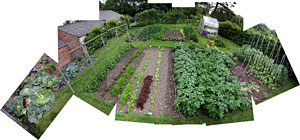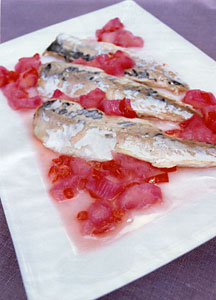Post #123
Tender is the night
10th January 2004, late evening | Comments (8)
In our garden, the vegetable garden, there sits a terracotta bell. It’s about knee high and the top lifts off so you can peer into the gloom at the soil below.
I’ve seen it there a million times, nestled amongst the lush growth in the spring and summer, matching colour with the beach hedge in the autumn, and standing alone in the winter time. Occasionally I’ve lifted the top off and looked in. Hmm, nothing there.
I’ve hit it with my football, I’ve run the wheelbarrow into it by mistake, I’ve got the hose caught on it a hundred times. I’ve even hidden a dead baby rabbit in there so the dog wouldn’t get it.
All these years, and it never occurred to me to ask what the hell it was for.
I suppose I must have wondered about it occasionally: it’s probably to stop the wind or cold tearing up a young plant; to stop slugs eating a lettuce; or keep the birds from the seeds. Or maybe it’s meant for storing dead baby rabbits away from the dog. Maybe that happens so often it necessitates a special terracotta bell and mum just never mentioned it to me. Who knows.
Well, now I know what it’s for — about ten minutes ago I worked it out and asked Mum if I was right:
- Dunstan
So, is that what it’s for?
- Mum
Of course it is! How did you not know that?
- Dunstan
- *mumble*
Well, you never tell me anything…
What’s it for? How did I work it out? Well, I happened to read this in the Daily Telegraph Magazine, and all became clear:
Tender is the night
By Rose Prince. Photos by Howard Sooley.
One you know what to look for, the buildings are everywhere. In this small area of Yorkshire most farms still have a long, low-built brick shed, barely high enough for a human to stand in. They could be stables — and many of them are — but that is not their original purpose. These are the forcing sheds of the Wakefield rhubarb triangle, the dark environment where bright pink winter rhubarb is grown.
The difference between this rhubarb and the khaki-red type that grows all summer is that indoor-grown rhubarb is tender and gently flavoured while outdoor — depending on the cook — can range from a stew of hellish strings to a great crumble.
December to March is the indoor rhubarb season, and now that there are so few forcing sheds in use it has become something exotic — with a scarcity value that has been recognised by chefs, full of praise for its unique taste. Forced rhubarb is now found in good restraunts more than ever; no longer simmering only under a sweet crumble but appearing in its true form as a vegetable despite its fruit character.
Rowley Leigh servers rhubarb with chilli and very fresh grilled mackerel — which is not as odd as you might think when you know that the French eat mackerel with gooseberries.
The history of forced grow rhubarb
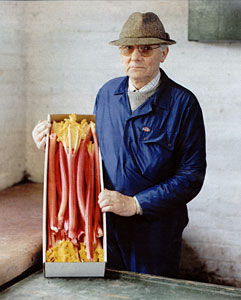
The article continues:
Forced rhubarb, grown in pitch darkness, is a story of obsessive horticulture, inspired economic make-do and typical English eccentricity.
Most people do a double-take on hearing that vegetables can be grown in the dark. It all began when a 19th-century farmer threw a rhubarb root into a manure heap and forgot about it … a few weeks later, [he] found the rhubarb had sprouted wan, pink stalks in the warmth of the rotting heap that were infinitely nicer to eat than the tough stuff he’d grown that summer.
…
It is the same “where there’s a will there’s a way” tenacity that saw fires lit against kitchen garden walls, warming them so that the peaches espaliered on the other side would ripen. It inspired gardeners to grow pineapples in pits of fresh hot dung, banana trees to thrive in Northumberland and numerous species that were way, way out of their hemisphere to sprout in hothouses or under closhes. Rhubarb also belongs to that family of vegetables — asparagus, sea kale and celery — whose edible stalks are much less fibrous when grown without light.
Growing the rhubarb in the dark
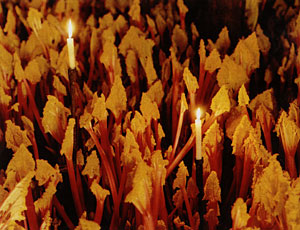
… the rhubarb roots begin life outdoors, but it will be three years before the root stock yields the first forced rhubarb.
We plant the rhubarb outside in fields for the first two seasons, then lift the dormant roots and leave them on top of the soil and wait for cold weather,Davis Westwood says.
The dormancy of the plant is broken by the cold — maybe frosty weather or cold rain. We then bring the roots into the sheds, on or around November 1, packing them in side-by-side on the floor. Within three weeks we should have a harvestVegetating in the absolute darkness of the heated sheds, the rhubarb searches desperately for light and in its pursuit it grows at twice [its normal] speed. For anyone frustrated by a plant’s ability to grow through a concrete path or hard tennis court, this is the explanation. The frantic energy of these plants is even audible.
Standing in a quiet rhubarb shed, you can hear a popping sound as the canopy covering the crown of the leaf opens; you can hear the rhubarb grow.Without daylight the rhubarb leaves are an anaemic green yellow, and the 2ft-long stalks smooth textured and crimson. The pickers must pull the stalks in the dark; any exposure to light will stop the growth of all the rhubarb and scupper the next harvest. By the end of March the harvest is over and the root stock, totally exhausted from its effort to find light, is composted.
…
We used to heat the sheds with coal and coke, but since the pit closures, we’ve had to use diesel for the heating systems and that’s very expensive. Also, rhubarb likes a lot of soot — I don’t know why, but soot in the atmosphere always helped it grow well. Now that we have this clean air policy, I use sulphur to create the same effect.
Picking the rhubarb
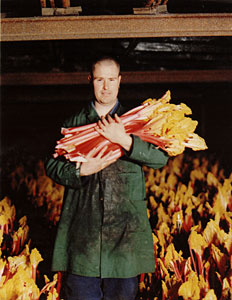
…Westwood, who enters ahead of me to warn the pickers not to swear in my presence, calls a warning over his shoulder —
mind your head— a second before my head smacks so hard into a low beam that my knees give way.
Are you all right?Fine, fine, I say. The old cliche of seeing stars is real enough but it soon becomes clear that they are not stars but the small flames of tall candles, on spiked holders rammed into the ground at approximately 10ft intervals near the line of men in the shed. It is an eerie scene. The shed is huge and it is impossible to see the back; a sea of stalks tipped with uncurling yellow leaves is just visible in the gloom. The line of men pulling the rhubarb gradually moves forward, the men chatting about the weekend with minimal use of the f-word and plenty of jokes at my expense.
So there you have it — my mum grows rhubarb in that terracotta bell. Obviously only on a small scale, but that’s what it’s for.
Apparently they used to grow it when she was a little girl — at the bottom of their garden they had a low coal shed, with two big doors that opened up and outwards, and in it my Grandad used to grow his rhubarb, in the dark.
I like that.
Jump up to the start of the post ↑
Blogmarks
A collection of miscellaneous links that don't merit a main blog posting, but which are interesting none-the-less.
Our enemies are innovative and resourceful, and so are we. They never stop thinking about new ways to harm our country and our people, and neither do we.
— George W Bush (9)- What WordPress is doing to combat comment spam. (1)
- Mobile web tools, from Pukupi. (1)
- Pukupi’s top 10 hints for building interoperable mobile Web sites. (3)
- The photography of E.J. Peiker. (4)
Stuff from the intersection of design, culture and technology.
(3)- Some handy tips for advanced Google use. (35)
- Make your own church signs, or view some real ones. (8)
- Michael Heilemann is doing a great job with his new WordPress theme; Kubrick. (1)
- I’m late to the party, but Dan has a book out. (1)
- What a crazy concept for laying out housing estates. (3)
- In San Francisco, I live here. (Try the zoom feature.) (1)
- Spider-Man reviews crayons. [Via] (3)
- Some beautiful images from photographer Greg Downing. (2)
- Lots of links, from the Link Bunnies. (1)
- Nice “when I was a child” sort of post from Stuart. (1)
- How much does SafariSorter cost? (4)
- Some handy maintenance tips for Mac owners running Panther. (2)
- Alex King launches Use Tasks: a hosted service for Tasks and Tasks Pro™. (2)
- Min Jung, Anil Dash, and I get interviewed for HBO’s Real Sex. (10)
Blog-roll
A selection of blogs I read on a regular basis.
- Hmm, the blog-roll seems to be a little bit broken right now (it may be that the blo.gs service is having problems). I’ve sent myself an email about this problem, and will try to fix it ASAP.
